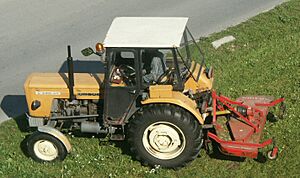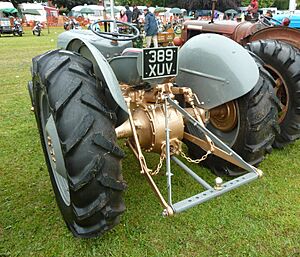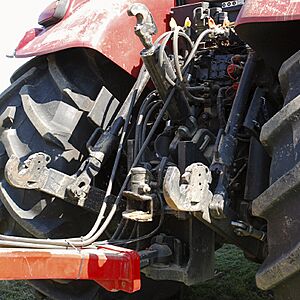Three-point hitch facts for kids
Quick facts for kids Three-point hitch |
|
|---|---|

Ursus C-360 tractor and mowing deck, attached by a three-point linkage and driven by a PTO shaft
|
|
| Classification | Tow hitch |
| Industry | Agriculture |
| Inventor | Harry Ferguson |
| Invented | 1926 |
The three-point hitch (also called a three-point linkage) is a super important part of modern tractors. It's like a special arm system that connects farm tools, called implements, to the back of a tractor. Imagine a triangle or the letter 'A' – that's what the three points look like!
This system helps the tractor and the tool work together as one unit. The tractor can carry some or all of the tool's weight. Before this, tools were often just pulled behind the tractor like a trailer, using a single connection point called a drawbar.
The best thing about the three-point hitch is how it helps the tractor get more grip on the ground. It takes the weight and resistance from the tool and pushes it down onto the tractor's drive wheels. This means a tractor can pull heavy tools even if it's not super big or heavy itself. For example, the Ford 9N tractor, which came out in 1939, was light and affordable. But thanks to its three-point hitch, it could plow a lot of land, even more than some bigger, more expensive tractors of its time! This smart design quickly became the standard for tractors everywhere.
Contents
Parts of a Three-Point Hitch
A three-point hitch is made of a few key parts that work together:
- Hydraulic System: This is the tractor's power system that uses fluid pressure to move things.
- Attaching Points: These are the spots where the tools connect.
- Lifting Arms: These are the parts that move up and down.
- Stabilizers: These keep the tool steady.
The hitch has three movable arms. The two lower arms are called the hitch lifting arms. They are controlled by the tractor's hydraulic system, which means the operator can make them lift, lower, and even tilt the tools. The arm at the top, called the top link, can also move, but it usually isn't powered by the hydraulics. Each arm has a special connector to attach the tools.
To connect a tool, you line up the tool's posts with the holes on the hitch arms. Then, you put a pin through the holes to secure the tool.
Modern three-point hitches often have a "draft control" system. This system can sense how much force it takes to pull the tool through the ground. If the tool hits something hard and the force increases, the hydraulic system automatically raises the arms a little. If the force decreases, it lowers them. This helps keep the tool at the right depth and protects the tractor.
Different Sizes of Hitches
There are five main sizes of three-point hitches, called categories. The higher the category number, the stronger the lifting arms are and the bigger the connector pins are. This means bigger tractors with more power use higher category hitches.
| Category | Tractor power | Top link pin diameter | Lift arm pin diameter | Lower hitch spacing |
|---|---|---|---|---|
| 0 | Up to 20 hp (15 kW) | 5⁄8 in (16 mm) | 5⁄8 in (16 mm) | 20 in (510 mm) |
| 1 | 20 to 45 hp (15 to 34 kW) | 3⁄4 in (19 mm) | 7⁄8 in (22 mm) | 28 in (710 mm) |
| 2 | 40 to 100 hp (30 to 75 kW) | 1 in (25 mm) | 1+1⁄8 in (29 mm) | 34 in (860 mm) |
| 3 | 80 to 225 hp (60 to 168 kW) | 1+1⁄4 in (32 mm) | 1+7⁄16 in (37 mm) | 40 in (1,020 mm) |
| 4 | More than 180 hp (134 kW) | 1+3⁄4 in (44 mm) | 2 in (51 mm) | 48 in (1,220 mm) |
There are also "N" (narrow) versions of these categories. They use the same pin sizes but are narrower. This helps larger tractors connect to smaller tools more easily.
History of the Three-Point Hitch
For a long time, farm tools were simply pulled behind tractors using a drawbar. This was similar to how horse-drawn tools worked. It was a simple system, but the three-point hitch brought many improvements.
A man named Harry Ferguson patented the three-point hitch in Britain in 1926. He believed it was important for farm tools, especially plows, to be firmly attached to the tractor. He spent many years developing, explaining, and selling his ideas.
Ferguson's special hitch design helped transfer the forces from the plow to the tractor's rear wheels. This pushed the drive wheels down, giving the tractor more grip. Because of this, Ferguson's tractors could be lighter and easier to steer than older models. They could also work on soft ground and caused less damage to the soil. Plus, they used less time and fuel!
The hydraulic system of the three-point hitch also had a clever feature: it could automatically control how deep the tool went into the ground. This helped manage the load on the tractor. Another great safety feature was that the three-point hitch could prevent the tractor from flipping backward if the tool hit a big rock or something immovable.
In 1938, after many years, Ferguson finally convinced Henry Ford to use his system on Ford's mass-produced tractors. The three-point hitch became widely available in America with the Ford-Ferguson 9N in 1939.
The "Ferguson system" wasn't just a hitch; it was a whole set of tools designed to work perfectly with it. In the 1940s, it became so popular that other tractor companies started making their own special hitch systems. Companies like International Harvester had their "Fast Hitch," and Allis-Chalmers had its "Snap-Coupler." These systems often made it easier to connect tools and control them from the tractor seat.
However, these different systems meant that tools from one brand might not work with a tractor from another brand. Farmers often had to buy tools from the same company as their tractor. This was sometimes frustrating for farmers who already had tools from other brands.
In the 1960s, the patents on Ferguson's technology ran out. This meant any company could use the design. Because of this, tractor and tool makers agreed to make the three-point hitch a standard system that all brands could use. This made things much easier for farmers! Today, almost all tractor companies use a standardized version of the three-point hitch. Many even offer kits to convert older, non-standard hitches to the modern three-point system.
See also
- Overrunning clutch
- Power take-off




